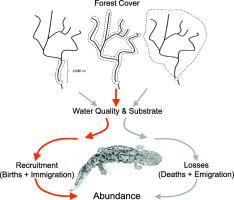当前位置:
X-MOL 学术
›
Biol. Conserv.
›
论文详情
Our official English website, www.x-mol.net, welcomes your
feedback! (Note: you will need to create a separate account there.)
Loss of catchment-wide riparian forest cover is associated with reduced recruitment in a long-lived amphibian
Biological Conservation ( IF 4.9 ) Pub Date : 2018-02-21 , DOI: 10.1016/j.biocon.2018.02.012 Catherine M. Bodinof Jachowski , William A. Hopkins
Biological Conservation ( IF 4.9 ) Pub Date : 2018-02-21 , DOI: 10.1016/j.biocon.2018.02.012 Catherine M. Bodinof Jachowski , William A. Hopkins

|
Land use alteration is recognized as a threat for many aquatic species, but demographic drivers of land use associated declines are poorly studied. We examined hellbender, demography in six stream reaches stratified across a land use gradient to understand how land use might influence a long-lived species. We used robust-design surveys (2014–2015) to estimate abundance and demographic structure, and all captures recorded between 2007 and 2015 to estimate demographic rates. Catchment-wide riparian (CWR) forest predicted demography better than catchment or local riparian forest. Across space, sub-adult/adult abundance declined and demographic structure became increasingly skewed towards older adults as CWR forest declined. Demographic rates indicated sub-adults/adults were being lost from each reach at a similar rate and most populations remained stable over the period for which data were available (1–8 years per reach). Our findings suggest recruitment (via births, juvenile survival and/or immigration) of young age classes facilitated stability of high-density populations when CWR forest was relatively high. When CWR forest was lower, survivorship and longevity of old adults facilitated persistence of low-density populations for multiple years while recruitment of young age classes suffered. Fine sediment was not correlated with land use but water temperature, conductivity and pH declined as CWR forest increased, highlighting water quality as a possible mechanism linking forest cover to hellbender demography. Our findings suggest maintaining forest in upstream riparian areas is critical for conserving downstream biota, and emphasize the difficulty of detecting declines in long-lived species when environmental alterations act specifically on recruitment of young age classes.
中文翻译:

整个流域河岸森林覆盖的丧失与长寿两栖动物的补充减少有关
土地利用改变被认为是对许多水生物种的威胁,但与土地利用相关的下降的人口驱动因素研究很少。我们对土地利用梯度上的六条溪流的人口统计进行了研究,以了解土地利用如何影响长寿物种。我们使用稳健设计的调查(2014-2015)来估计丰度和人口结构,并使用 2007 年至 2015 年记录的所有捕获来估计人口比率。流域范围的河岸 (CWR) 森林比流域或当地河岸森林更好地预测人口统计。在整个太空中,随着 CWR 森林的减少,亚成体/成体丰度下降,人口结构越来越向老年人倾斜。人口统计比率表明,每个河段的亚成体/成体正在以相似的速度流失,并且大多数种群在数据可用期间(每个河段 1-8 年)保持稳定。我们的研究结果表明,当 CWR 森林相对较高时,年轻群体的招募(通过出生、幼体生存和/或移民)有利于高密度种群的稳定。当 CWR 森林较低时,老年人的生存和长寿促进了低密度种群的持续存在,而年轻群体的招募则受到影响。细沉积物与土地利用无关,但随着 CWR 森林的增加,水温、电导率和 pH 值下降,这凸显了水质是森林覆盖与地狱动物人口统计学之间联系的可能机制。我们的研究结果表明,维护上游河岸地区的森林对于保护下游生物群至关重要,并强调当环境变化特别影响幼龄物种的招募时,很难发现长寿物种的减少。
更新日期:2018-02-21
中文翻译:

整个流域河岸森林覆盖的丧失与长寿两栖动物的补充减少有关
土地利用改变被认为是对许多水生物种的威胁,但与土地利用相关的下降的人口驱动因素研究很少。我们对土地利用梯度上的六条溪流的人口统计进行了研究,以了解土地利用如何影响长寿物种。我们使用稳健设计的调查(2014-2015)来估计丰度和人口结构,并使用 2007 年至 2015 年记录的所有捕获来估计人口比率。流域范围的河岸 (CWR) 森林比流域或当地河岸森林更好地预测人口统计。在整个太空中,随着 CWR 森林的减少,亚成体/成体丰度下降,人口结构越来越向老年人倾斜。人口统计比率表明,每个河段的亚成体/成体正在以相似的速度流失,并且大多数种群在数据可用期间(每个河段 1-8 年)保持稳定。我们的研究结果表明,当 CWR 森林相对较高时,年轻群体的招募(通过出生、幼体生存和/或移民)有利于高密度种群的稳定。当 CWR 森林较低时,老年人的生存和长寿促进了低密度种群的持续存在,而年轻群体的招募则受到影响。细沉积物与土地利用无关,但随着 CWR 森林的增加,水温、电导率和 pH 值下降,这凸显了水质是森林覆盖与地狱动物人口统计学之间联系的可能机制。我们的研究结果表明,维护上游河岸地区的森林对于保护下游生物群至关重要,并强调当环境变化特别影响幼龄物种的招募时,很难发现长寿物种的减少。











































 京公网安备 11010802027423号
京公网安备 11010802027423号